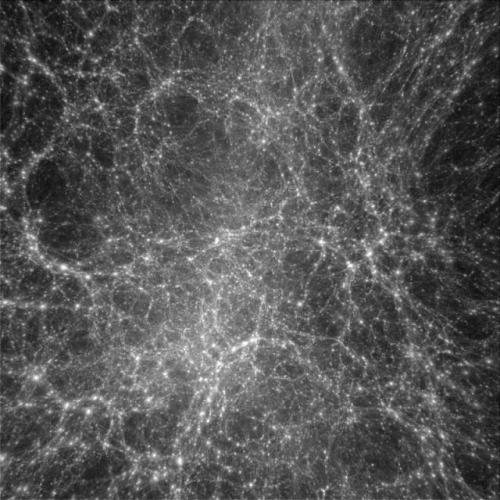Researchers at the University of Tokyo’s Institute for the Physics and Mathematics of the Universe and Nagoya University used large-scale computer simulations and recent observational data of gravitational lensing to reveal how dark matter is distributed around galaxies.

The new research concludes that galaxies have no definite “edges.” Instead galaxies have long outskirts of dark matter that extend to nearby galaxies and the intergalactic space is not empty but filled with dark matter.
The research article has been published in the February 10th issue of The Astrophysical Journal. (preprint)
It is well known that there is a large amount of unseen matter called “dark matter” in the universe. It constitutes about 22 percent of the present-day universe while ordinary matter constitutes only 4.5 percent. An important question still remains: Where is most of the dark matter in the universe?
Einstein’s general theory of relativity predicts that a light ray passing near a massive object such as a galaxy is bent by the effect called “gravitational lensing”. For example, the effect causes the image of a distant galaxy to be deformed and brightened by an intervening galaxy. However the effect itself is very small and so cannot be easily detected for a single galaxy. Only recently, images of millions of galaxies from Sloan Digital Sky Survey (SDSS) made it possible to derive an averaged mass distribution around the galaxies. Earlier in 2010, an international research group led by Brice Menard then at University Toronto and Masataka Fukugita at IPMU used twenty four million galaxy images from the Sloan Digital Sky Survey (SDSS) and successfully detected gravitational lensing effect caused by dark matter around the galaxies. From the result, they determined the projected matter density distribution over a distance of a hundred million light-years from the center of the galaxies.
Masataka Fukugita and Naoki Yoshida at IPMU, together with Shogo Masaki at Nagoya University, used very large computer simulations of cosmic structure formation to unfold various contributions to the projected matter distribution. They showed that galaxies have extended outskirts of dark matter, well beyond the region where stars exist. The dark matter distribution is well organized but extended to intergalactic space, whereas luminous components such as stars are bounded within a finite region. More interestingly, the estimated total amount of dark matter in the outskirts of the galaxies explains the gap between the global cosmic mass density and that derived from galaxy number counting weighted by their masses. A long standing mystery on where the missing dark matter is now solved by the research. There is no empty space in the universe. The intergalactic space is filled with dark matter.
<한글기사>
우주비밀 밝혀지나..암흑물질 분포 최초 확인
일본 물리학자들이 암흑물질의 위치를 처음으로 확인해 우주의 거의 모든 영역에 분포돼 있음을 밝혀냈다고 주장했다.
암흑물질은 빛에 반응하지 않기 때문에 우리 눈에 보이지는 않지만 그것이 일반 물질에 가하는 중력 때문에 간접적인 방식으로 존재가 확인되고 있다.
일본 과학자들은 컴퓨터 시뮬레이션을 이용해 최근 관찰한 2천400만개의 은하에 관한 자료를 모델로 만들었다.
이들은 이를 통해 암흑물질이 각 은하들로부터 은하 간 우주까지 뻗어 있고 부근의 다른 은하들로부터 나오는 암흑물질과 겹쳐지면서 우 주 전체를 감싸는 그물망을 형성한다는 사실을 발견했다고 천체물리학 저널 최신호 에 발표했다.
연구진은 은하의 빛이 지구로 오는 동안 어떻게 구부러지는지, 즉 중력 렌즈 효 과가 어떻게 나타나는지 밝혀내 빛을 구부러지게 만드는 암흑물질의 위치를 밝힐 수 있었다.
이 연구에 따르면 은하들은 다른 은하들로부터 수백만광년의 거리를 두고 분리 된 뚜렷한 테두리 안의 한정된 영역이 아닌 것으로 밝혀졌다. 따라서 `은하간 우주'라는 용어 자체도 맞지 않는다는 것이다.
은하들은 실제로는 눈에 보이는 일반 물질이 중심부에 몰려 있고 가장자리를 암 흑물질 그물이 감싸고 있는 모양인데 암흑물질은 이웃 은하까지 절반 거리는 가지런 하게 펼쳐져 있어 우주는 은하와 관련된 물질로 채워져 있다고 연구진은 설명했다.
더 나아가 우리가 `은하'라고 부르는 것은 이처럼 연결되는 물질분포가 가장 높 은 밀도를 이루는 것일 뿐이라고 이들은 지적했다.
연구진은 각 은하의 중심부로부터 1억광년에 걸쳐 암흑물질이 분포돼 있는 모습 을 지도로 작성했으며 여기에 나타난 암흑물질의 분포는 "무작위적이거나 획일적이 지 않으며 매우 가지런하다"고 밝혔다.
현재 전세계적으로 암흑물질을 추적하는 수많은 연구가 진행중인데 과학자들은 암흑물질이 윔프(WIMP: 약하게 상호작용하는 질량이 큰 입자)로 이루어져 있을 것으 로 추정하고 있다.
윔프는 질량이 양성자의 몇 배가 되며 중력과 약한 원자력을 통해서만 상호작용 을 한다.
중력을 이용한 간접적인 방식의 계산 결과 암흑물질은 우주를 차지하는 물질과 에너지중 22%를 차지하는 것으로 밝혀졌다. 이에 비해 눈에 보이는 일반물질이 차지 하는 비율은 4.5%에 불과하다. (연합뉴스)







![[Graphic News] More Koreans say they plan long-distance trips this year](http://res.heraldm.com/phpwas/restmb_idxmake.php?idx=644&simg=/content/image/2024/04/17/20240417050828_0.gif&u=)
![[KH Explains] Hyundai's full hybrid edge to pay off amid slow transition to pure EVs](http://res.heraldm.com/phpwas/restmb_idxmake.php?idx=644&simg=/content/image/2024/04/18/20240418050645_0.jpg&u=20240419100350)





![[From the Scene] Monks, Buddhists hail return of remains of Buddhas](http://res.heraldm.com/phpwas/restmb_idxmake.php?idx=652&simg=/content/image/2024/04/19/20240419050617_0.jpg&u=20240419175937)

![[KH Explains] Hyundai's full hybrid edge to pay off amid slow transition to pure EVs](http://res.heraldm.com/phpwas/restmb_idxmake.php?idx=652&simg=/content/image/2024/04/18/20240418050645_0.jpg&u=20240419100350)

![[Today’s K-pop] Illit drops debut single remix](http://res.heraldm.com/phpwas/restmb_idxmake.php?idx=642&simg=/content/image/2024/04/19/20240419050612_0.jpg&u=)